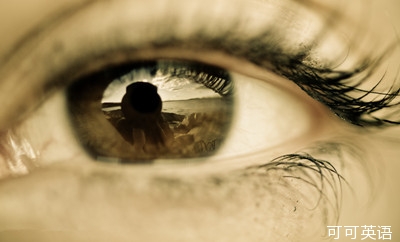In the 1964 film Goldfinger, James Bond thwarts a would-be attacker approaching from behind after seeing the man's reflection in the eyes of the woman he's about to kiss.
在1964年上映的電影《金手指》中,詹姆斯·邦德因?yàn)樵趯⒁H吻的邦女郎眼中反射出在自己身后男子的影像化解了一場即將發(fā)生的襲擊事件。
It was enough for Bond to know somebody was approaching.
邦德先生就是憑借這點(diǎn)知道要接近自己的是誰。
 But now U.K. researchers want to fully identify individuals based on corneal reflections.
But now U.K. researchers want to fully identify individuals based on corneal reflections.
但是現(xiàn)在在英國的研究人員們想要了解從角膜反射出影像的全部信息。
Rather than sneaking up on people, the researchers simply took high-res photos of their subjects' faces.
除了悄悄接近人們,研究人員對他們的樣本臉部進(jìn)行高分辨率的成像。
From those digital pictures, they zoomed in on the subjects' eyes to examine images of bystanders reflected in the cornea.
從這些數(shù)字圖像中,他們放大了人臉樣本中的眼部區(qū)域,檢測從眼角膜中反射出旁觀者的圖像信息。
Turns out those reflected images might indeed be useful for real-life crime fighting, according to the research, published in the journal PLOS One.
結(jié)果顯示這些反射出的圖像也許確實(shí)對現(xiàn)實(shí)中的打擊犯罪活動(dòng)有所幫助,這項(xiàng)研究已經(jīng)在《公共科學(xué)圖書館之一》雜志上發(fā)表。
The researchers found that volunteers could usually correctly match a person's image in a fuzzy corneal reflection with a normal headshot of that same person.
研究人員發(fā)現(xiàn)參與研究試驗(yàn)的志愿者們一般情況下都能正確地將模糊成像下的眼角膜反射影像與同一個(gè)人的頭部正常頭像照片匹配出來。
Such data extraction could be useful for solving crimes in which hostages or abuse victims are photographed.
這種抽取的數(shù)據(jù)信息或許對諸如對人質(zhì)或虐待受害人等相關(guān)犯罪活動(dòng)且有影像資料證據(jù)的情況下解決有用。
In these cases, the victims' eyes would essentially become mirrors, recording incriminating information about their captors. Q would have been impressed.
這些情況下,受害人眼部本質(zhì)上就像鏡子一樣會(huì)記錄下犯罪過程的相關(guān)信息。如果真的這樣Q先生估計(jì)會(huì)很感動(dòng)的。
 But now U.K. researchers want to fully identify individuals based on corneal reflections.
But now U.K. researchers want to fully identify individuals based on corneal reflections.










